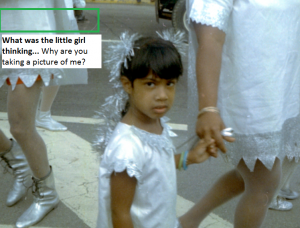DHSS Assignment Guides
Historical Image Analysis
Historical Image Analysis as a DHSS Assignment
Featuring work from Denise Challenger‘s exhibit “Playin’ Mas, Play and Mas: A pedagogical journey of children and Caribana, 1970-1974”
For a historian, engaging in image analysis is not an unusual task. There are several image analysis worksheets available online for different levels of learners, including ones from the National Park Service (American), the National Archives (American), the Canadian War Museum, the North Dakota State Government, the Illinois State Museum, and the Virginia Museum of History & Culture (some worksheets are designed for younger learners but can be adapted for students in higher education).
Historian and project member Denise Challenger demonstrated the process of image analysis in her exhibit, “Playin’ Mas, Play and Mas: A pedagogical journey of children and Caribana, 1970-1974”. In her exhibit, she tracked her initial reflections of photographs in her digitized archive and then engaged in a more structured reflection of selected images.
However, the real “meaning making” potential for photo analysis in DHSS is that your students can engage in photo analysis with a range of historical images that were not created as digital objects. Digital photos are now so ubiquitous that we can forget that photos that are at least 20 years old, especially popular photos, were not created digitally and were taken in a finite series with unexpected results (i.e. a roll of 24 photos that you had to wait to see until they were developed).
What DHSS can bring to historical image analysis then, is having images themselves – originally digitally or not – available to us on our laptops, phones, or tablets for analysis and, with appropriate permissions, “remixing” and creatively transforming them to tell new stories about the past.
Summary
Description:
- The examination of digital images from a historical point of view
Possible tools/technologies:
- Scalar
- Omeka
- Flickr
- PowerPoint
- Prezi
Elements of Process:
- Identify photographs
- View the photograph and answer specific questions about their content and context
- Put ideas together to make a historical argument based on one’s analysis
- Present the analysis
Size of assignment:
- Small to Medium
Difficulty:
- Low to Moderate
For her exhibit “Playin’ Mas, Play and Mas: A pedagogical journey of children and Caribana, 1970-1974,” Denise did two stages of historical photo analysis: initial reflection and structured reflection. In the initial reflection, she made notes about what she saw and then moved to structured reflection where she asked 10 questions of each photograph:

- Are there people in the photograph?
- What are they doing?
- What expressions are on their faces? What is their body language?
- What objects are in the photograph?
- When was the photograph taken?
- Where was the photograph taken?
- Where is the photographer standing in relation to the subject (above, below, in front of, beside, etc.)?
- How would the picture change if he or she was standing in a different place?
- Is this photo spontaneous or posed? How can you tell?
- What is the general mood of the photograph? How can you tell?
Denise shared the answers to her questions through “pop up,” interactive annotations in a Scalar exhibit like Juan Pablo’s public education analysis. To replicate their work, one would have to be familiar with using Scalar; however, your students can present their analysis of a digital image using something they are more familiar with like WordPress or in a photosharing site like Flickr. There are surprisingly not as many photo analysis tools for DHSS as one would think. Thus, to show students’ analyses, you can be creative in the tools your students already know, such as PowerPoint or Prezi, as well as integrate their formal analysis into other assignments, such as developing an exhibit, creating metadata, mapping, or proving/disproving an argument.
However, engaging in analysis through the lens of DHSS should invite students to think about the “digitalness,” for lack of a better word, of a historical photograph that was not created digital. Or other words, the historical specificity of viewing these photographs as digital items should be a highlight of your students’ analyses DHSS. Historical photo analysis should therefore not just ask Denise’s questions above, but also questions such as:
- What is the meaning behind capturing this image?
- Who was the intended audience?
- What is familiar about this image?
- What is surprising?
- What insight does this give us into the past that we would not have without this image?
- How does this image demonstrate the “we were there/they were there” element that historical photographs can demonstrate?
Historical Photo Analysis suggestions
Images can be chosen from archived sources but also collections of unidentified photos that can be found on Instagram, Flickr, and other photosharing sites. In many ways, asking your students to analyze less-common photographs than the ones used in class may elicit more complex discussions during content analysis.

